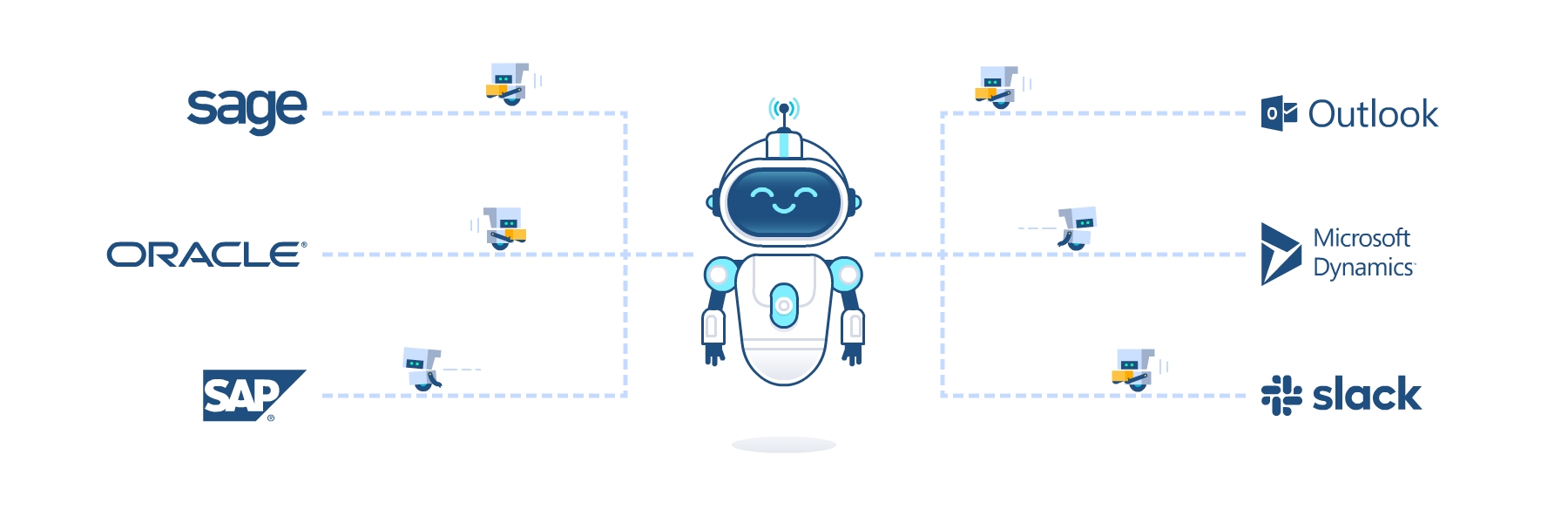
How will businesses cope with the growing volume of systems and data they'll face in the coming years? We propose that an enterprise virtual assistant – an EVA – can help them gain more value from their data, and more productivity from their workforces.
Virtual assistants have been in our personal lives for a good few years now, through smart speakers, phones and laptops, they have crept into the daily routines of millions, because they help cut friction. There’s no hunting the right app, they're handsfree and they help cut through the noise to find the right info and issue commands easily.
As consumer tech and trends have in the past filtered into the enterprise space, assistants will become commonplace among businesses as well. If not for the familiarity workers have with them as an interface, then for the huge productivity potential they offer for companies.
Businesses are being overwhelmed by data
The volume of data businesses generate on a daily basis is growing exponentially; IBM estimates that 90% of all data in history was created within the last two years. This vast amount of information is already overwhelming companies, and there are no signs of this trend slowing down.
Companies need to start making use of this data to not be left behind; only 9% of companies considered themselves “very effective” in getting value from their generated data, and less than half said their organisation is “somewhat effective.” Companies are using data, but they are not getting anywhere near the amount of value from it as they could be, and this is only set to continue.
Achieving value from data can be hard, especially when that data is spread across disconnected sources. Siloed systems and data are costing companies time and money, with 68% of companies indicating that “siloed data negatively impacts their organisation somewhat or to a great extent.” With only 3% asserting it has no negative impact the company at all. The more difficult it is to find and extract this data, the more resources are spent trying to create value from it.
On top of poorly connected systems, companies also have huge amounts of data sitting outside of digital systems. An estimated 80 per cent of enterprise data, sometimes more, is stored as plain text, scanned documents, video or other forms that keep it from ready analysis. Businesses have traditionally stored data in an unstructured, natural language way, advertently or not, and while the push towards digital transformation has boosted the amount of data available to be analysed, it hasn’t and almost certainly never will eliminate unstructured data. Rather than supressing or avoiding unstructured data, companies need to find ways to unlock it and extract its value.
System proliferation is holding back worker productivity
To complete a day’s tasks workers must navigate an ever-increasing number of systems. Enterprises use an average of 1,295 cloud services, with over 300 services between marketing and HR alone. The modern knowledge worker uses over nine apps every day, with most people having between 5 and 9 work-related apps open at any one time. Jumping between these different apps and services introduces context switching and breaks workflow, introducing inefficiencies into an employee’s daily work.
Workers also spend too much time carrying out administrative tasks, leaving less time to spend on critical tasks. A survey found that employees spend 15 weeks each year on ’pointless’ jobs at work; over two hours a day. Streamlining the workflows of administrative tasks represents a major cost saving to companies.
Disorganised information causes problems for workers regularly. A Forrester/Microsoft report about knowledge workers found that 50% of respondents report interruptions to their workflows due to inability to find or access data that they need. This means they cannot remain focused on their essential work, causing yet more inefficiencies throughout the company.
Technology is improving at such a quick rate, yet many business processes have remained mostly unchanged for years, and individual integrations between systems is a time consuming project often not capable of keeping pace with the rate of change. The technology to tackle these problems already exists; it’s just about creating a great solution.

Upon receipt of a user request, an EVA dispatches 'skillbots' to provide it with the right data and integrations to fulfil the request.
What’s an EVA?
We believe an enterprise virtual assistant (EVA) can help solve these problems.
Virtual assistants are programs that can perform tasks and answer queries based on natural language commands and questions. They are already widespread amongst the general public and are slowly embedding themselves into daily lives. The most popular used today are Amazon Alexa, Google Assistant and Apple’s Siri, with sales of the former two’s smart speakers estimated to be over 200m in Western markets. It’s predicted that by 2023 there will be 8 billion digital voice assistants in use. As public acceptance and usage grows, familiarity with their capabilities and interaction models has grown as well, and demand for their handiness within the workplace has grown.
Indications are that enterprise virtual assistants will follow the path of their consumer counterparts and become a regular part of our lives with predictions that 25% of digital workers will use virtual employee assistants daily by 2021, a major step up up from 2% using them 2019. This uptake in virtual assistants in the workplace environment is obvious when you start to think of the benefits they could bring in supporting in routine daily tasks:
- “Can you book next week off work for me?”. An EVA can send a request to an HR department, and once approved, notify you, notify your team, and update your calendar, cutting a multi-stage task down to one.
- "Has anyone been looking into progressive web apps?". Technical or subject matter questions can be answered with a suggestion who to talk to, within or outwith the company, by building a profile of them based on their position, department, documents authored, network they speak within, comments and conversations made on internal public channels and many more data sources.
- “Can you book me a meeting with Jon tomorrow? We'll need a projector” can lead to a check against both calendars to find the best time, recommend a meeting space convenient to both of you, make smart assumptions about the length of time and equipment required and make all of the necessary arrangements.
EVAs are about adding a smart, natural language layer between your data and your workers. They are about cutting out the non-productive time and tasks from your workers’ days, and cutting the number of microactions needed to complete a task.
By having a single point of entry to the systems and large amounts of data of an enterprise, workers can spend more time on valuable work. A report by Harmon.ie shows that “People consistently agreed that if they could have all information made available in one place, it would make their experience at work better.” Less time will be spent looking for documents, switching between programs, and completing administrative tasks.
The increase in productivity from an EVA could be worth billions across industry. Liberty Mutual alone is now experiencing 8-10 million dollars in productivity savings year on year thanks to their enterprise virtual assistant.
What are Screenmedia doing in this space?
We've long invested heavily in R&D to keep our practice and our clients at the leading edge of our industry. In the past this has seen us record a number of firsts within our industry and markets, and be some of the earliest adopters of mobile, responsive web, IoT and voice technologies. This year we are undertaking our most ambitious investment yet. In our research we couldn't find an EVA solution which suited the needs of our clients; there are plenty of chatbots, but none which could cope with a broad range of functionalities; services like Microsoft Power Assistant are a move in the right direction, but are light-touch and don't offer the depth and complexity we were looking for. So we decided to build our own.
We want to create a single unifying interface, available wherever you are, through whatever channel you prefer, that can access all of your company’s data and use it to provide an answer to any question or fulfil any action while catering the response to the user based on personal needs, goals, role and location. It should be able to assemble information from multiple data sources, control dozens of other smart systems, and learn by itself over time.
We’re at the start of this project so our EVA (we've named it Osborne!) can’t do much at the moment, and there will be plenty of challenges along the way, as there ever is with R&D projects, but we're looking forward to keeping you up to date with our progress. Get in touch if you want to find our more about our work.
